소아청소년 안전사고 예방, Safety accident prevention for children and adolescents
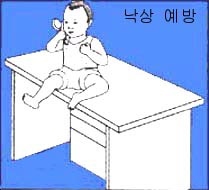
그림 5-10. 낙상 예방.
높은 곳에서 떨어져 다칠 수 있다. 아이가 높은 곳에 올라가지 않도록 주의해야 한다.
Copyright ⓒ 2011 John Sangwon Lee, MD., FAAP
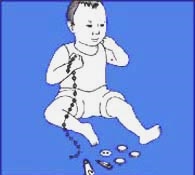
그림 5-11. 인두 강, 식도관, 위장관 등 소화기 내로 들어갈 수 있거나 기도 속으로 흡인될 수 있는 것을 영유아들이 노는 주위에 방치해서는 안 된다.
Copyright ⓒ 2011 John Sangwon Lee, MD., FAAP

그림 5-12. 화학물질중독 사고 예방.
특히 영유아가 약물, 독극물이나 화학물질을 마시고 중독될 수 있다. 독극물 등은 항상 안전한 곳에 보관해야 한다.
Copyright ⓒ 2011 John Sangwon Lee, MD., FAAP
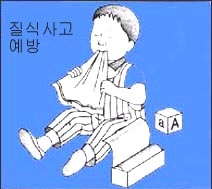
그림 5-13. 질식사고 예방.
입에 얇은 종이나 고무풍선, 땅콩, 포도알 등을 넎고 놀면 기도 속으로 들어가 기도가 막혀 질식할 수 있다.
Copyright ⓒ 2011 John Sangwon Lee, MD., FAAP
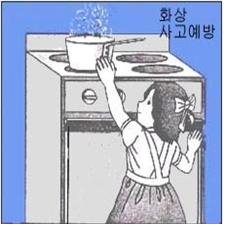
그림 5-14. 열, 전기, 화학 물질, 방사선, 가스, 뜨거운 액체나 증기로 인한 열탕상을 예방한다.
끓는 물이나 뜨거운 스토브 등에 데지 않도록 주의한다.
Copyright ⓒ 2011 John Sangwon Lee, MD., FAAP
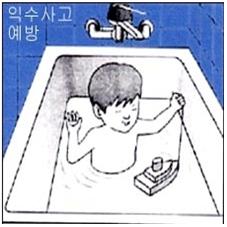
그림 5-15. 익사 예방.
물속에서 아이 혼자서 놀지 않도록 한다.
배를 타고 여행을 떠나기 전 구명복을 입는 법, 구명 보오트를 이용하는 법, 수영할 수 있지지 부모는 책임지고 확인 해야 한다. Copyright ⓒ 2011 John Sangwon Lee, MD., FAAP
- 어리고 사리판단력이 미숙하고, 엄마아빠들의 부주의로, 또는 다른 여러 가지 이유로 소아청소년들에게 안전사고가 더 잘 생길 수 있다.
- 안전사고는 1세 이후 소아청소년사망의 주원인이다.
- 2003년, 미국 1~4세 유아들의 전 사망의 원인 중 34.6%, 5~9세의 유아, 초기 학령기 아이들의 전 사망의 원인 중 37.5%, 10~14세 10대 아이들의 전 사망의 원인 중 37.5%, 15~19세 10대 아이들의 전 사망의 원인 중 49.7%가 안전사고로 인한 사망이었다.
- 아이들에게 안전사고가 나지 않게 소아청소년 안전사고 예방 교육을 철저히 해야 한다.
- 엄마아빠들은 물론이고 각 급 학교의 교사들, 의료계종사자, 특히 소아청소년과 전문의들을 비롯한 사회와 국가가 소아청소년 안전사고 예방교육을 소아청소년들에게 계속 해야 한다.
- 국가는 엄마아빠 소아청소년 안전사고 예방교육을 엄마아빠들에게 시키는 정책을 세우고 그를 통해 의무적으로 안전사고 예방교육을 시키고 엄마아빠, 소아청소년, 사회 국가가 모두가 다 같이 모든 안전사고 예방에 힘써야한다.
- 어린 자녀들에게 안전사고가 생기지 않게 예방하는 데는 엄마아빠들에게 1차적으로 책임이 있다. 국가나 사회, 또는 그 누구의 책임보다 더 크고 중요하다는 것을 쉽게 이해할 수 있다.
- 소아청소년과는 소아청소년 안전사고 예방교육을 소아청소년 건강검진을 주기적으로 해 줄때 소아청소년의 나이에 적절하게 해주는 것이 기본이다.
- 실제로, 엄마아빠들이 영유아 자녀에게 소아청소년 안전사고 예방을 주로 하고, 그 후도 엄마아빠들은 물론 각 급 학교 사회 국가가 소아청소년 안전 예방을 위해서는 힘써야 한다.
- 안전사고가 소아청소년들에게 나지 않게 예방하면 소아청소년 들에게 날 수 있는 거의 대부분의 안전사고는 잘 나지 않는다.
- 소아청소년 안전사고 예방에 관한 영역은 방대하다.
- 예를 들면 캠핑사고, 전기 감전사고, 총기 사고, 도보 사고, 중독사고, 익수 익사 사고, 짐승 교상, 애완동물 교상, 질식사고, 낙상, 화상, 화제, 학교 운동사고, 장난감 사고 등에 관련된 안전사고와 그 예방이 소아청소년 양육 상 상당히 중요하다.
- 소아청소년들에게 보다 더 흔히 생길 수 있는 안전사고와 그 예방대책에 대해 다음 명한다. 참조문헌; Noah New York, Online Access to Health, Others
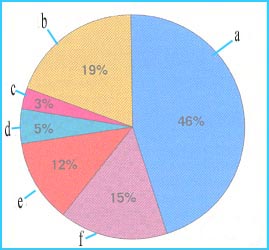
a-안전사고, b-타살, c-자살, d-악성 종양, e-심장 질환, f-그 외 원인
출처- 2002년 사망한 미 청소년 33,009명의 사망의 원인을 분석한 CDC의 통계
Safety accident prevention for children and adolescents 소아청소년 안전사고 예방

Figure 5-10. Prevention of falls. Children may fall from high places and injure themselves. Be careful not to let your child climb high. Copyright ⓒ 2011 John Sangwon Lee, MD., FAAP

Figure 5-11. Things that can enter the digestive tract, such as the pharyngeal cavity, the esophagus, and the gastrointestinal tract, or that can be aspirated into the airways, should not be left around children’s play. Copyright ⓒ 2011 John Sangwon Lee, MD., FAAP

Figure 5-12. Prevention of chemical poisoning accidents. In particular, infants and toddlers can become intoxicated by drinking drugs, poisons or chemicals. Toxins should always be kept in a safe place. Copyright ⓒ 2011 John Sangwon Lee, MD., FAAP

Figure 5-13. Prevention of suffocation. If children play with a thin piece of paper or a hot air balloon, peanuts, or grape grains in their mouth, they can enter the airways and block the airways and cause choking. Copyright ⓒ 2011 John Sangwon Lee, MD., FAAP

Figure 5-14. Prevents burns caused by heat, electricity, chemicals, radiation, gas, and hot liquids or vapors. Be careful not to burn it with boiling water or a hot stove. Copyright ⓒ 2011 John Sangwon Lee, MD., FAAP

Figure 5-15. Prevention of drowning. Avoid playing alone in the water. Parents are responsible for checking how to wear a life jacket, use a lifeboat, and swim before going on a boat trip. Copyright ⓒ 2011 John Sangwon Lee, MD., FAAP
- Children and adolescents are more susceptible to safety accidents because they are young and have poor judgmental skills, carelessness by mothers and fathers, or for a number of other reasons.
- Safety accidents are the main cause of deaths in children and adolescents after the age of one.
- In 2003, 34.6% of the causes of all deaths in children aged 1 to 4 in the United States, 37.5% of all deaths in children aged 5 to 9, and early school-age children, among the causes of all deaths in teens aged 10 to 14 37.5% and 49.7% of all deaths in teens aged 15-19 were due to safety accidents.
- Children and adolescents should be thoroughly trained to prevent accidents to prevent safety accidents.
- Society and the state, including mothers and fathers, as well as teachers at each level of the school, medical professionals, especially pediatricians and specialists, should continue to provide children with safe accident prevention education for children and adolescents.
- The state establishes a policy to provide mothers and fathers with safe accident prevention education for children and adolescents, and through it, it is compulsory to provide safe accident prevention education, and all mothers and fathers, children and adolescents, and the social state should all strive to prevent all safety accidents.
- Mothers and fathers are primarily responsible for preventing safety accidents in young children.
- It is easy to understand that it is greater and more important than the responsibilities of the state, society, or anyone else. In the Department of Pediatrics and Adolescents, it is fundamental to provide education on the prevention of safety accidents for children and adolescents appropriate to the age of children and adolescents when they regularly perform health check-ups for children and adolescents.
- In fact, mothers and dads mainly prevent safety accidents for infants and young children, and even after that, mothers and dads as well as the school and social state should strive to prevent the safety of children and adolescents.
- If safety accidents are prevented from occurring to children and adolescents, almost all safety accidents that can occur to children and adolescents do not occur well.
- The field of prevention of safety accidents for children and adolescents is vast.
- For example, safety accidents related to camping accidents, electric shock, gun accidents, walking accidents, poisoning accidents, drowning accidents, animal biting, pet biting, choking accidents, falls, burns, hot topics, school exercise accidents, toy accidents, etc. Its prevention is of great importance in raising children and adolescents.
- Safety accidents can occur more frequently among children and adolescents and preventive measures are given in the following order. References; Noah New York, Online Access to Health, Others

- Figure 5-16. Safety accidents are the most common cause of death among American youths aged 15 to 24. a-safety accident, b-kill, c-suicide, d-malignant tumor, e-heart disease, f-other causes Source-CDC statistics analyzing the causes of deaths of 33,009 US adolescents who died in 2002
출처 및 참조문헌
- www.drleepediatrics.com 제1권 소아청소년 응급 의료
- www.drleepediatrics.com 제2권 소아청소년 예방
- www.drleepediatrics.com 제3권 소아청소년 성장 발육 육아
- www.drleepediatrics.com 제4권 모유,모유수유, 이유
- www.drleepediatrics.com 제5권 인공영양, 우유, 이유식, 비타민, 미네랄, 단백질, 탄수화물, 지방
- www.drleepediatrics.com 제6권 신생아 성장 발육 육아 질병
- www.drleepediatrics.com제7권 소아청소년 감염병
- www.drleepediatrics.com제8권 소아청소년 호흡기 질환
- www.drleepediatrics.com제9권 소아청소년 소화기 질환
- www.drleepediatrics.com제10권. 소아청소년 신장 비뇨 생식기 질환
- www.drleepediatrics.com제11권. 소아청소년 심장 혈관계 질환
- www.drleepediatrics.com제12권. 소아청소년 신경 정신 질환, 행동 수면 문제
- www.drleepediatrics.com제13권. 소아청소년 혈액, 림프, 종양 질환
- www.drleepediatrics.com제14권. 소아청소년 내분비, 유전, 염색체, 대사, 희귀병
- www.drleepediatrics.com제15권. 소아청소년 알레르기, 자가 면역질환
- www.drleepediatrics.com제16권. 소아청소년 정형외과 질환
- www.drleepediatrics.com제17권. 소아청소년 피부 질환
- www.drleepediatrics.com제18권. 소아청소년 이비인후(귀 코 인두 후두) 질환
- www.drleepediatrics.com제19권. 소아청소년 안과 (눈)질환
- www.drleepediatrics.com 제 20권 소아청소년 이 (치아)질환
- www.drleepediatrics.com 제21권 소아청소년 가정 학교 간호
- Red book 29th-31st edition 2021
- Nelson Text Book of Pediatrics 19th- 21st Edition
- The Johns Hopkins Hospital, The Harriet Lane Handbook, 22nd edition
- Childhood Emergencies in the Office, Hospital and Community, American Academy of Pediatrics
- Emergency Medical Service for Children, By Ross Lab. May 1989. p.10
- Emergency care, Harvey Grant and Robert Murray
- Emergency Care Transportation of Sick and Injured American Academy of Orthopedic Surgeons
- Emergency Pediatrics A Guide to Ambulatory Care, Roger M. Barkin, Peter Rosen
- Immediate care of the acutely ill and injured, Hugh E. Stephenson, Jr
- The Critically Ill Child, Diagnosis and Management, Edited by Clement A. Smith
- Emergency Medical Services for Children: The Role of the Primary Care Provider, America Academy of Pediatrics
- Quick Reference To Pediatric Emergencies, Delmer J. Pascoe, M.D., Moses Grossman, M.D. with 26 contributors
- Manual of Emergency Care
- 응급환자관리 정담미디어
- 소아가정간호백과–부모도 반의사가 되어야 한다, 이상원
- Neonatal Resuscitation American heart Association
- Neonatology Jeffrey J.Pomerance, C. Joan Richardson
- Pediatric Resuscitation Pediatric Clinics of North America, Stephen M. Schexnayder, M.D.
- Pediatric Critical Care, Pediatric Clinics of North America, James P. Orlowski, M.D.
- Preparation for Birth. Beverly Savage and Dianna Smith
- Infectious disease of children, Saul Krugman, Samuel L Katz, Ann A. Gershon, Catherine Wilfert
- The Harriet Lane Handbook 19th Edition
- 소아과학 대한교과서
- 제1권 소아청소년 응급의료 참조문헌과 출처
- 제2권 소아청소년 질병․안전사고 예방 참조문헌과 출처
- Other
Copyright ⓒ 2015 John Sangwon Lee, MD., FAAP
“부모도 반의사가 되어야 한다”-내용은 여러분들의 의사로부터 얻은 정보와 진료를 대신할 수 없습니다.
“The information contained in this publication should not be used as a substitute for the medical care and advice of your doctor. There may be variations in treatment that your doctor may recommend based on individual facts and circumstances. “Parental education is the best medicine.”